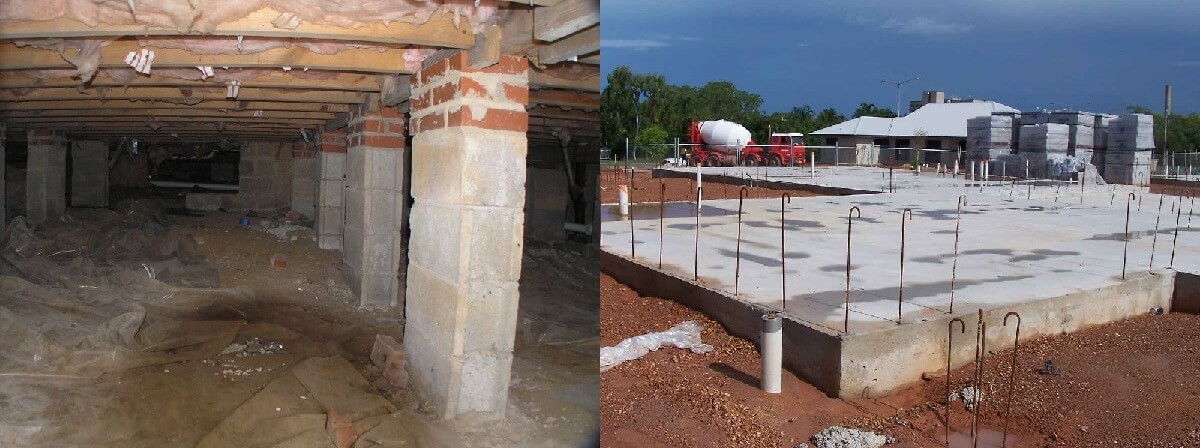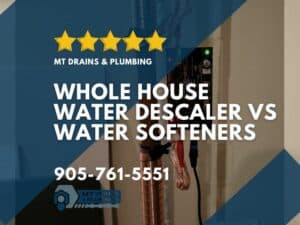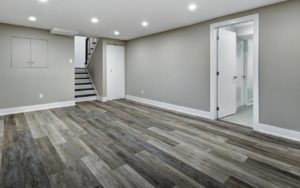Is it better to have a crawlspace or slab? This is a common question among those planning to build a house. A crawlspace used to be the primary type of foundation, but today, however, slab foundations are becoming more popular.
A crawlspace is a raised foundation with footings and block-walls around the exterior to support the house, elevating the house 1½ – 4 feet above the ground. Concrete or cinder blocks extend from the footings, closing the space off except at ventilation openings. A slab foundation is a layer of poured concrete, six inches thick, installed directly on the ground to support the house.
Each type of foundation has its advantages and disadvantages. It’s imperative to compare the pros and cons of each when choosing the best option for your new home construction.
Continue reading this crawlspace vs. slab comparison to learn which one will best meet your needs.
Crawlspace vs. Slab: Location and Climate Requirements
A crawlspace foundation is ideal for sloped areas, allowing you to custom design the footers to level your house’s flooring. They also work better in earthquake-prone areas than their slab counterparts, as a slight shift in the earth can permanently damage a slab foundation.
Crawlspaces are also ideal for soils like red clay since they aren’t stable enough to support a concrete slab. Construction experts recommend this foundation type for dryer climates as moisture tends to accumulate there.
If you live in a flood-prone region, consider a crawlspace foundation. This type of foundation will raise your house, minimizing the chances of interior flooding when water levels rise.
However, a slab foundation is ideal for a wet climate not prone to floods. Slab foundations have a vapor barrier that prevents mold from getting into the house.
Slab vs. Crawlspace: Cost of Construction
Slab foundations are often less expensive to build, since opting for a crawlspace is similar to designing a mini basement. You’ll be faced with the cost, durability issues, and other challenges of building a basement.
Crawlspaces require a concrete footing, a short foundation wall, wall and floor insulation, a drainage system, and exterior damp-proofing membranes. Crawlspaces also require weeping tile and the construction of a floor over the top of your crawlspace.
Building a slab foundation involves fewer stages. The main steps include laying down insulated forms, adding rebar plus mesh, and pouring the concrete.
Crawlspace vs. Slab: Durability
If installed by a qualified professional, both foundation types can last about 50 years. While slabs are more robust and can support heavy furniture and appliances, they are prone to cracking due to the growth of tree roots and shifts in soil.
Crawlspaces, on the other hand, are susceptible to termite damage. Moisture and flooding can also compromise their structural integrity. When it comes to plumbing repairs, it’s often easier to repair a leaky pipe or shower pan in a crawlspace than in a slab foundation.
However, concealed water leaks can result in the decay of the surrounding wood, making repairs more costly. The same leak may not affect the integrity of a concrete slab, but repairs may require removing and rebuilding a part of the foundation.
The repair process can be more expensive and time-consuming than the same-sized area of damage in a crawlspace foundation.
Slab vs. Crawlspace: Energy Efficiency
A slab foundation is more energy efficient. You can vent a crawlspace foundation to minimize moisture build-up, but keep in mind that ventilation also allows cold air to blow underneath your house.
The floor supports and subflooring can transfer the low temperatures from the crawlspace to the living space above, meaning you’ll spend more to keep your home comfortable than the owner of a house with a slab foundation.
A common remedy to this problem is installing insulation inside foundation walls and between the floor supports. Although this insulation minimizes cold transfer, it is not 100% effective. If you live in a cold region, you may also need to insulate the plumbing that lies within your crawlspace or apply electrical heat tape to prevent pipes from freezing.
Slab vs Crawlspace: Comfortability
A slab foundation results in a hard surface, and sometimes even the best floor coverings can’t make a concrete slab as comfortable as a floor above a crawlspace. Crawlspace floors are often crafted with wood, making them more comfortable surfaces to stand and walk on.
Crawlspace vs. Slab: Ease of Remodelling
A slab foundation makes it difficult to alter the floor plan of a house. In a home with a slab foundation, plumbing is embedded in the concrete, meaning you’ll have to break parts of the foundation to change its configuration, negatively affecting the entire slab’s structural integrity in the process.
For a home built on a crawlspace, you can move the bathroom and kitchen location from one side of the house to another and can also reconfigure plumbing within the crawlspace beneath.
Crawlspace vs. Slab: Sealing & Maintenance Costs
Slabs don’t require much maintenance. Waterproofing concrete foundations usually costs between $5 and $10 per square foot, and you can expect to spend between $3 and $6 per foot on damp-proofing a concrete slab.
On the other hand, crawlspaces require regular maintenance and checks for moisture. Remediating water damage in a crawlspace can cost you anywhere from $200 to $4,000, and encapsulating a crawlspace can cost you about $5,000.
Final Thoughts
Both crawlspace and slab foundations offer a range of benefits and downfalls. The best option will depend on location, climate, building and maintenance costs, and personal preference. If you’re planning to build a house and you’re unsure which type of foundation is right for you, consult a reputable professional.
Whether you have a crawlspace or slab foundation, and you’re experiencing plumbing and drainage issues, MT Drains and Plumbing can help. Our certified and experienced plumbers can detect the problem in your plumbing system and fix it for good.
If you live in Vaughan, Toronto, Markham, Newmarket, Richmond Hill, or other surrounding areas, get in touch with our team by calling (905) 761-5551 or filling the Quote Request Form on our website.






